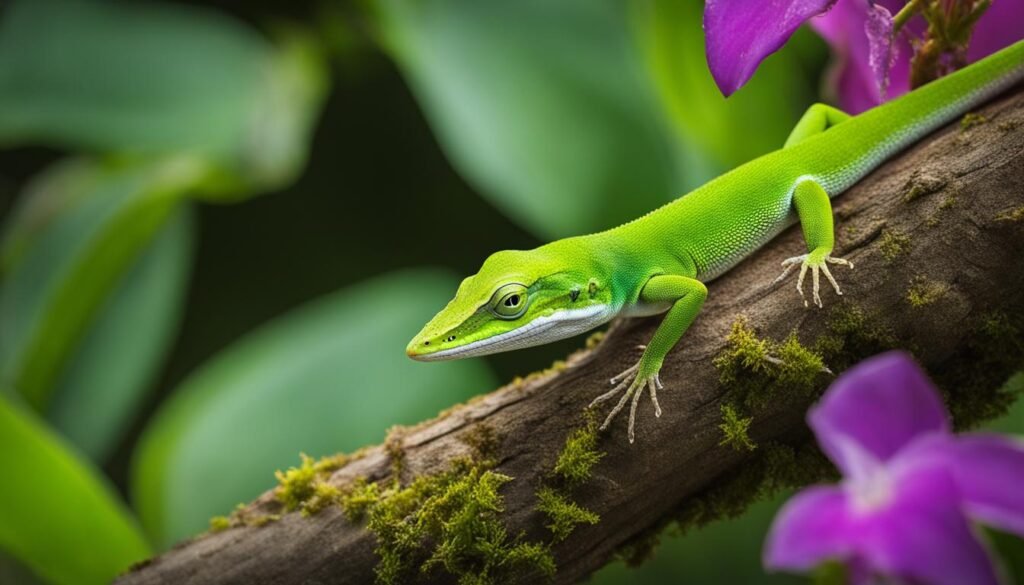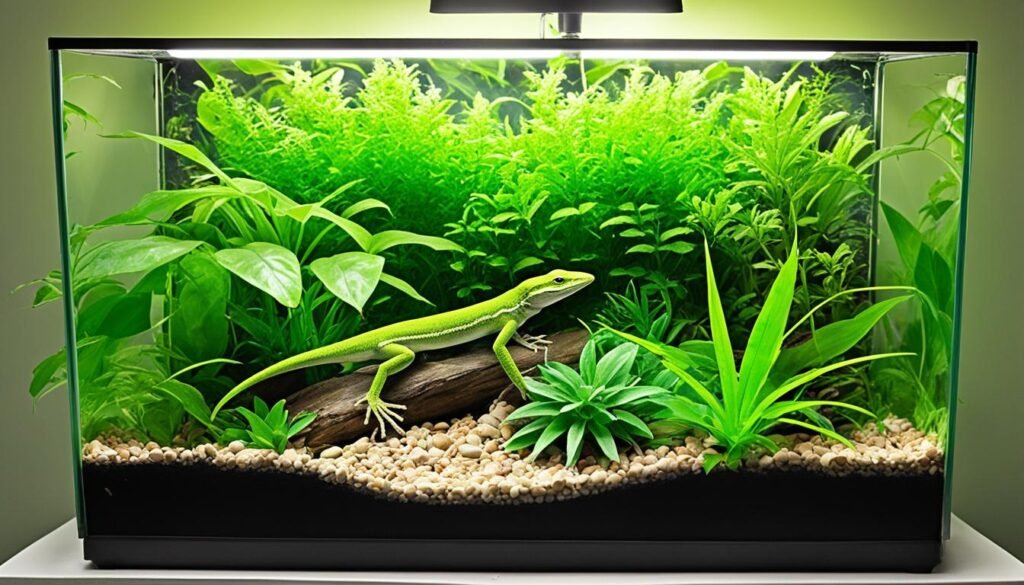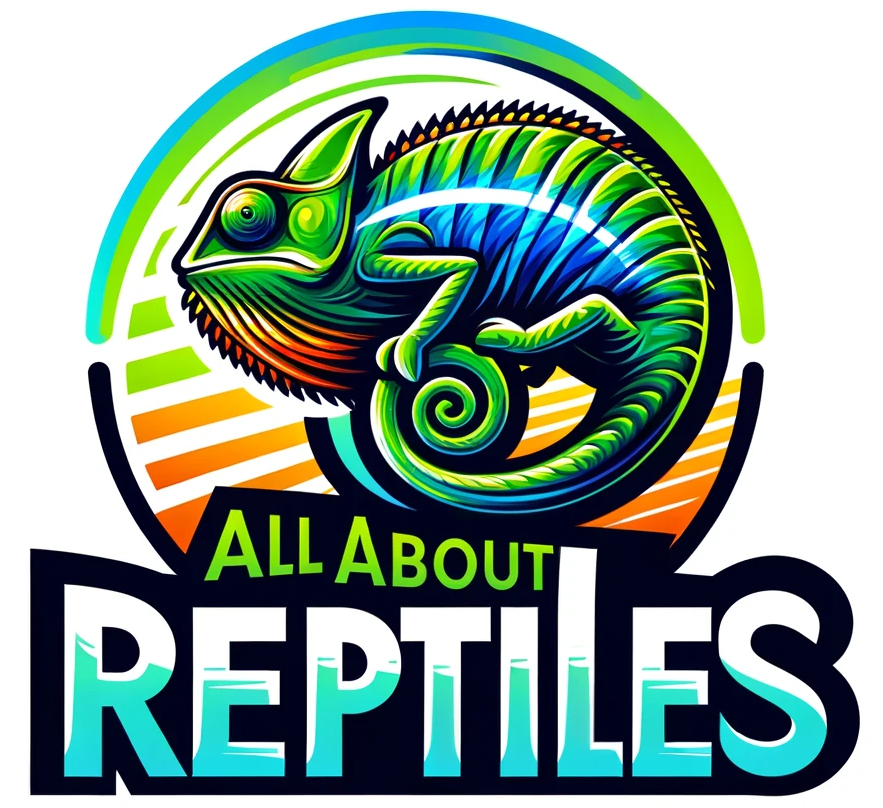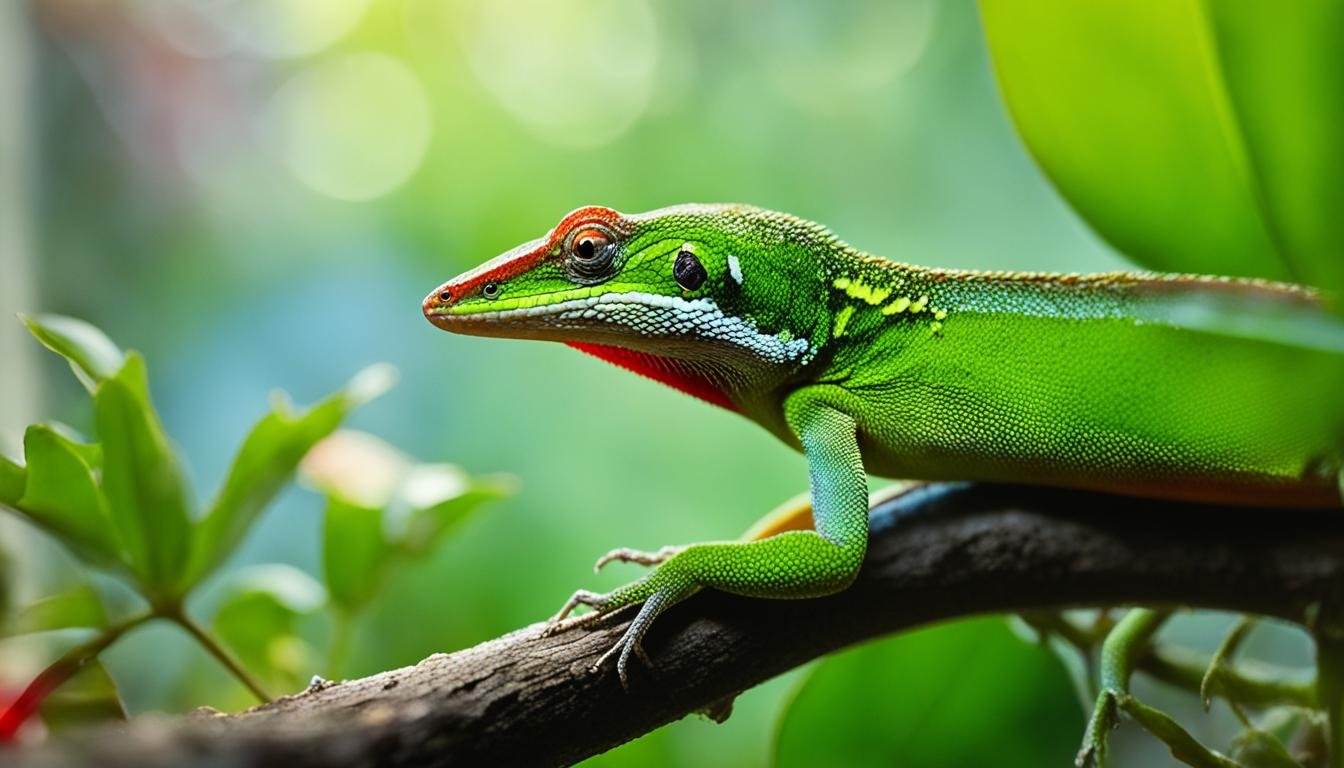Did you know that anoles, a species of lizard known for their tree-living behavior and color-changing abilities, can grow up to 8 inches in length and have an average lifespan of 5 years? These fascinating creatures require specific care to ensure their well-being and happiness as pets. From creating the perfect habitat to understanding their dietary needs and behavior, there are several key factors to consider when providing optimal care for anoles.
Key Takeaways:
- Anoles are tree-living lizards that can grow up to 8 inches in length and have an average lifespan of 5 years.
- Anoles require a properly set up habitat, including a 10-gallon terrarium with appropriate substrate, lighting, temperature, humidity, and decor.
- Anoles primarily eat gut-loaded insects such as crickets and should be supplemented with treats and vitamins.
- Handling anoles should be done with care, and thorough hand washing after contact is essential.
- If you notice signs of illness or distress in your anole, it is important to contact a veterinarian for assistance.
6 Cool Facts About Anoles
When it comes to fascinating reptiles, anoles certainly take the spotlight. These tree-living lizards have captivated researchers and enthusiasts alike with their unique characteristics. Let’s explore six cool facts about anoles that you may not have known:
- Anoles are tree-living lizards: These agile reptiles are adapted to life in trees, using their strong limbs and specialized toes to navigate their arboreal habitats.
- Anoles can grow up to 8 inches in length: While their size may vary across different species, anoles can reach an impressive length of up to 8 inches, making them a visually striking reptilian companion.
- Anoles have an average lifespan of 5 years: Although their lifespans can be influenced by factors such as habitat and care, anoles typically live for around 5 years.
- Male anoles can be dominant and territorial: In the world of anoles, males often assert their dominance and defend their territory from rival males through fascinating displays of color and physical prowess.
- In the wild, groups of anoles often consist of mostly females and one male: Anoles show an interesting social dynamic where groups are predominantly composed of females, forming a harem-like structure.
- Anoles can change color based on mood and environment: One of the most captivating abilities of anoles is their aptitude for changing color. From vibrant greens to browns, yellows, or grays, their hues transform to match their emotions and surroundings.
These cool facts shed light on the intriguing world of anoles, showcasing their unique adaptations, behaviors, and captivating appearances.
| Fact | Description |
|---|---|
| Anoles are tree-living lizards | Anoles are perfectly suited for life in the trees, with their strong limbs and specialized toes. |
| Anoles can grow up to 8 inches in length | An impressive size for a lizard, anoles can reach lengths of up to 8 inches. |
| Anoles have an average lifespan of 5 years | While lifespan can vary, an average of 5 years is common for this lizard species. |
| Male anoles can be dominant and territorial | Male anoles assert dominance and defend their territory, often engaging in colorful displays. |
| In the wild, groups of anoles often consist of mostly females and one male | Anole groups commonly have a one-male-to-many-females structure. |
| Anoles can change color based on mood and environment | An incredible adaptation, anoles alter their coloration to blend in or communicate their emotions. |
Things to Consider When Learning How to Take Care of an Anole
As a beginner-friendly reptile, anoles can make great pets for reptile enthusiasts. To ensure the health and well-being of your anole, it is important to understand their specific care requirements and provide the right reptile supplies. Here are some key things to consider when learning how to take care of an anole:
- Anole habitat: Anoles need a suitable habitat that mimics their natural environment. A 10-gallon terrarium provides ample space for them to live comfortably.
- Appropriate substrate: Choosing the right substrate is crucial for maintaining proper hygiene in the enclosure. Coconut-fiber or moss bedding are commonly used options.
- Lighting and temperature: Anoles require proper lighting to replicate natural sunlight. A UVA/UVB bulb should be installed in their terrarium for 12 hours daily. Maintaining the right temperature gradient is also important for their overall well-being.
- Humidity: Anoles thrive in environments with moderate humidity levels. Regular misting and the use of moisture-retaining substrates can help maintain the required humidity.
- Decor: Creating a stimulating and enriching habitat for your anole is essential. Provide hiding places, rocks, live plants, and branches for climbing to ensure they feel secure and comfortable.
- Insect food: Anoles are insectivores and need a diet primarily consisting of gut-loaded insects. Feeding them a variety of appropriately sized crickets and supplementing with treats is crucial for their nutritional needs.
- Reptile supplies: Having the right reptile supplies on hand is essential for anole care. Consider investing in a reptile starter kit, which includes the necessary items for their habitat, such as a terrarium, substrate, lighting, and decor.
By understanding and providing these essential elements, you can create a comfortable and suitable environment for your anole. Proper care and attention will help ensure their health and happiness as they thrive in their new home.
What Should Go in My Anole’s Habitat?
Creating the perfect habitat for your anole is essential to ensure its health and happiness. Here’s a detailed breakdown of what you need to include in your anole’s terrarium:
Terrarium Size
Providing your anole with ample space to explore and climb is vital. A 10-gallon terrarium is suitable for most anoles, allowing them enough room to move around comfortably.
Substrate
Choose a suitable substrate that mimics your anole’s natural habitat. Coconut-fiber or moss bedding are great options as they retain moisture and provide a soft surface for your anole to walk on.
Lighting
Anoles require proper lighting to thrive. Install a UVA/UVB bulb in their terrarium and ensure it is on for 12 hours a day to mimic natural sunlight. This promotes good health and helps with their overall well-being.
Temperature
Anoles require a temperature gradient in their terrarium to regulate their body temperature. The top of the tank should be maintained at 85-90°F, while the bottom should be 75-85°F during the day. At night, the whole tank should be around 65-75°F. Use a thermometer to monitor and adjust the temperature accordingly.
Heating
To maintain the proper temperature, you can provide heating through a heat bulb or a ceramic heat emitter. This ensures that your anole stays warm and comfortable throughout the day and night.
Humidity
Anoles require a humid environment to thrive, around 60-80% humidity. You can achieve this by misting the terrarium daily and using moisture-retaining substrates. Monitoring humidity levels with a hygrometer is recommended.
Habitat Decor
Creating a natural and enriching environment for your anole is essential. Include hiding places, rocks, wood, live plants, and branches for climbing. This helps create a sense of security and provides opportunities for exercise and exploration.
| Item | Description |
|---|---|
| Terrarium Size | 10-gallon terrarium for adequate space |
| Substrate | Coconut-fiber or moss bedding for moisture |
| Lighting | UVA/UVB bulb for 12 hours a day |
| Temperature | Top at 85-90°F, bottom at 75-85°F during the day, and 65-75°F at night |
| Heating | Heat bulb or ceramic heat emitter for warmth |
| Humidity | 60-80% humidity through misting and moisture-retaining substrates |
| Habitat Decor | Hiding places, rocks, wood, live plants, and branches for climbing |
By providing anole-friendly habitat, you’ll create a comfortable and stimulating environment for your pet’s overall well-being and natural behaviors.
What Should I Feed My Anole?
Anoles are insectivores and should be primarily fed gut-loaded insects such as crickets. They should be fed 2-5 crickets daily, with insects no bigger than half the size of their head. Treats such as mealworms and phoenix worms can be given once or twice a week. Anoles should also be dusted with calcium reptile supplement 2-3 times per week and a multivitamin once a week. Fresh water should be provided in a shallow dish, and the enclosure should be misted to maintain hydration.
When it comes to anole diet, it’s important to provide them with their natural food sources. As insectivores, anoles thrive on a diet of gut-loaded insects. The primary food they should consume is crickets. These should be fed to the anole in appropriate quantities, typically 2-5 crickets per day. It’s essential that the crickets are no bigger than half the size of the anole’s head to avoid any potential choking hazards.
In addition to crickets, anoles can also enjoy treats such as mealworms and phoenix worms. These can be given as a special treat once or twice a week to provide variety in their diet.
To ensure proper nutrition, anoles should be dusted with a calcium reptile supplement 2-3 times per week. This helps to maintain their calcium levels, which are essential for their bone health. Additionally, a multivitamin should be provided once a week to ensure they receive all the necessary vitamins and minerals.
Proper hydration is also crucial for anole health. Fresh water should be provided in a shallow dish within their enclosure. It’s important to regularly check and refill the water to ensure it remains clean and accessible. To maintain proper humidity levels, the enclosure can also be misted to provide moisture for the anoles.
By following these dietary guidelines, anole owners can ensure that their pets receive a balanced and nutritious diet, promoting their overall health and well-being.
Advice for Handling Your Anole
When handling anoles, it is important to be gentle and minimize stress. To ensure the well-being of your anole, consider the following pet safety tips:
- Allow for acclimation: New anoles should not be handled for at least 3-4 days to allow them to adjust to their new environment.
- Exercise caution: Anoles can bite, especially when stressed. Handle them with care and avoid excessive force or sudden movements.
- Supervise children: When children are around anoles, ensure they are supervised closely to prevent harm to both the child and the anole.
- Practice thorough hand washing: Before and after handling an anole or their habitat, wash your hands thoroughly to prevent the spread of disease.
Remember, proper hygiene is crucial when handling any animal, including anoles. By following these tips, you can create a safe and enjoyable experience for both you and your pet.
| What to Do | What to Avoid |
|---|---|
| Be gentle and minimize stress | Avoid excessive force or sudden movements |
| Allow new anoles to acclimate before handling | Do not handle new anoles for at least 3-4 days |
| Supervise children closely | Do not leave children unattended with anoles |
| Practice thorough hand washing | Do not neglect hand hygiene before and after handling |
When Should I Contact the Vet?

If you are considering an anole as a pet, it is essential to find a veterinarian who is familiar with anole health and care before bringing one home. Regular veterinary check-ups are recommended, and prompt attention should be sought if you notice any signs of illness or distress in your anole.
Anole health is a vital aspect of responsible pet ownership, and veterinary care plays a crucial role in ensuring the well-being of these fascinating reptiles. Here are some signs that indicate it is time to contact a vet:
- Avoiding basking: If your anole is spending more time hiding and avoiding its basking spot, it could be a sign of an underlying health issue.
- Eating or drinking less: A sudden decrease in appetite or thirst can indicate an illness or discomfort.
- Weight loss: If you notice significant weight loss in your anole, it is essential to seek veterinary care as it may be a symptom of an underlying problem.
- Swollen joints: Swollen joints can be a sign of infection or injury and require prompt attention from a veterinarian.
- Discharge from the eyes, nose, or mouth: Unusual discharge from these areas can indicate an respiratory or gastrointestinal issue.
- Runny droppings: Changes in stool consistency, such as runny or unusually colored droppings, can be indicative of a gastrointestinal problem.
- Shedding problems: If your anole is experiencing difficulties shedding its skin, it may require veterinary assistance.
- Discolored skin: Any abnormal changes in the coloration of the skin should be evaluated by a veterinarian.
Remember, as anole owners, we must be vigilant when it comes to their health. Prompt veterinary attention is crucial to maintain the well-being and happiness of these fascinating creatures.
Green Anole Care Overview
Green anoles make excellent reptile pets, especially for beginners. They are known for their low maintenance and easy care requirements. These fascinating creatures are native to certain areas of the United States and feature a simple yet charming appearance.
A notable characteristic of green anoles is their ability to change colors, adding an element of intrigue to their presence. While their average lifespan in captivity is around 4 years, with proper care and attention, they can lead healthy and fulfilling lives.
Providing the right care for green anoles is essential to ensure their well-being and happiness. By understanding their unique needs and creating an optimal environment, you can enjoy a rewarding experience as a green anole owner.
Why Choose Green Anoles as Reptile Pets?
- Low maintenance: Green anoles are relatively undemanding in terms of their care requirements.
- Beginner-friendly: Their ease of care makes them suitable for beginners in the world of reptile pet ownership.
- Charming appearance: The simple yet captivating appearance of green anoles adds beauty to any reptile habitat.
The Importance of Green Anole Care
Proper care is crucial for green anoles to thrive and lead healthy lives. By meeting their specific needs, you can ensure their overall well-being and prevent potential health issues. Key areas of green anole care include their habitat, diet, and health maintenance.
Green Anole Habitat and Tank Size
Creating an ideal habitat is vital to provide a comfortable living space for green anoles. It is recommended to house them in a spacious and secure enclosure with proper ventilation. A ten-gallon vertical terrarium or reptile tank is suitable for one or a pair of green anoles. Placing the enclosure in a high area, such as shelves or bureaus, can help reduce stress.
Green Anole Diet and Health
Green anoles are insectivorous reptiles that primarily feed on small insects like crickets and mealworms. Along with their diet, it’s important to ensure they receive proper hydration and exposure to UVB lighting. Regularly monitoring their health, cleanliness of the enclosure, and seeking veterinary care when necessary are integral parts of responsible green anole care.
Green Anole Habitat and Tank Size

Creating the ideal habitat for your green anoles is essential for their health and well-being. These reptiles require a spacious and secure enclosure that provides proper ventilation and replicates their natural environment. The size and setup of the tank play a crucial role in ensuring their comfort and happiness.
A small terrarium or reptile tank is suitable for one or two green anoles. Ideally, a ten-gallon vertical tank is recommended, as it allows for vertical climbing space and ample room to explore. Placing the tank in a high area, such as shelves or bureaus, helps reduce stress and provides a sense of security for these arboreal creatures.
The tank should be equipped with appropriate substrate, hiding spots, branches, and live plants. These elements mimic their natural habitat and provide opportunities for climbing, exploring, and basking. Here is a checklist for setting up the perfect green anole habitat:
- 10-gallon vertical terrarium
- Proper substrate (coconut fiber or moss bedding)
- Securely fitted screened lid for ventilation
- Hiding spots (such as rocks or artificial caves)
- Branches for climbing
- Live plants (non-toxic to anoles)
By creating a habitat that meets the needs of your green anoles, you can provide them with a comfortable and enriching living space.
| Size of Tank | Suitable for |
|---|---|
| 10-gallon vertical terrarium | 1-2 green anoles |
Green Anole Diet and Health
As insectivores, green anoles have specific dietary requirements to ensure their health and well-being. Their diet primarily consists of small insects, such as crickets and mealworms, which provide essential nutrients. It is important to offer a varied diet to prevent nutritional deficiencies.
To supplement their diet, it is recommended to provide green anoles with calcium and vitamin D3. These nutrients promote strong bone health and aid in the absorption of calcium. Calcium can be provided through powdered supplements, which can be lightly dusted onto the insects before feeding them to the anoles.
Hydration is crucial for the overall health of green anoles. Their water needs can be met through misting the enclosure, which creates water droplets for the anoles to drink from. Anoles also obtain hydration from the moisture in the insects they consume.
Regular monitoring of the health of your green anoles is essential. Keep an eye out for any signs of illness, such as changes in behavior, appetite, or appearance. It is also important to maintain a clean and hygienic enclosure to minimize the risk of infections or parasites.
Proper lighting is another crucial aspect of green anole care. UVB lighting is necessary for the synthesis of vitamin D3, which helps regulate calcium metabolism and supports the overall well-being of the anoles. Be sure to provide an appropriate UVB light source and follow the recommended lighting schedule.
To ensure the best care for your green anoles, regular veterinary check-ups are recommended. A reptile-savvy veterinarian can provide routine examinations, offer guidance on proper care, and address any health concerns that may arise.
| Dietary Requirements for Green Anoles | Recommendations |
|---|---|
| Primary Diet | Insects (crickets, mealworms) |
| Supplements | Calcium and vitamin D3 |
| Hydration | Misting enclosure and moisture from insects |
| Health Monitoring | Regular observations, cleanliness of enclosure |
| Lighting | UVB light source for vitamin D3 synthesis |
| Veterinary Care | Regular check-ups with a reptile-savvy veterinarian |
Conclusion
Green anoles are fascinating reptile pets that can thrive with proper care and understanding. By creating the ideal habitat, understanding their dietary needs, maintaining their health, handling them with care, and enriching their behavior, owners can ensure their green anoles are healthy and happy. Responsible ownership and prioritizing the well-being of the green anole should always be the goal.
FAQ
What are anoles?
How big do anoles grow?
What is the average lifespan of anoles?
Are male anoles territorial?
What is the composition of a group of anoles in the wild?
Can anoles change color?
Are anoles suitable pets for beginners?
What supplies are essential for anole care?
What should be included in an anole’s habitat?
What do anoles eat?
How should anoles be handled?
When should I contact the vet for my anole?
What is green anole care like?
What size tank is suitable for green anoles?
What do green anoles eat?
References
| Organization Name | URL |
| International Reptile Conservation Foundation (IRCF) | https://www.ircf.org/ |
| Herpetological Conservation International | https://herpconservation.com/index.html |
| Society for the Study of Amphibians and Reptiles (SSAR) | https://ssarherps.org/about-ssar/ |


9 thoughts on “Anole Care 101: Tips for Healthy, Happy Pets”